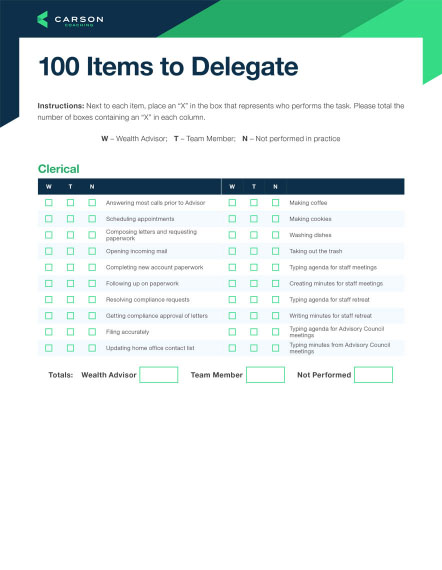You’ve spent so much time and effort on your prospecting process, and you now have a few new clients to onboard.
And you only have one chance to make a good first impression with your onboarding process. It’s during this foundational process where you establish the tone for what your client will come to expect in terms of service and communication.
“A wonderful onboarding experience confirms the decision the clients made to hire you as an advisor,” said our VP of Coaching and Consulting, Sarah M. Cain. “When the experience wows them, they are more likely to refer their friends and family.”
Which is critical, says Greg Opitz, Carson Executive Business Coach. “One of the best sources of new business is referrals from brand new clients,” he said.
U.S. News and World Report also notes that an organized onboarding process helps you establish trust with your clients. That’s why you have to design a great client onboarding process that’s as seamless and easy for your client (and repeatable for you) as possible.
But an organized onboarding process isn’t always the easiest thing for advisors to build and execute.
My colleague, Executive Business Coach Michael Rose, notes that advisors excel in many areas, but processes and procedures remain a challenge.
“I used to joke that most advisors would be challenged to put together a project plan to get from First Avenue to Second Avenue,” Michael said. “It’s the classic Rocket Fuel thing – most advisors are visionaries and do extremely well in those areas, but find getting ideas into action very difficult.”
And, as Opitz always likes to say: Vision is easy, execution is hard.
In this blog post, I’ll lay out three things to consider in building – and executing – a client onboarding process that creates raving fans.
Set Up a Client Service Matrix
One of the great things – but also one of the things that holds a lot of planners back – is they don’t do a good job of segmenting their services to their clients.
To that end, the first step in setting up a client onboarding process is to segment the services you’ll offer to different client types. In other words, based on your different client types, identify the different services, communication and appreciation that are provided to each.
This is done most efficiently with a client service matrix. In a sample client service matrix we’ve designed in Excel, we recommend segmenting your clients from A+ to NexGen (A+, A, B, C, D, F, NexGen). Then decide what services to offer each segment in the following realms:
- Investment management
- Financial planning
- Tax planning
- Estate planning
- Risk management
- Review and update meetings
- Communication from the firm
- Other touches
Then you fill out the matrix with X’s indicating what service is included for each client segment, a dollar sign ($) for what you will offer that segment for a separate fee, and leave it blank if you don’t offer a particular service.
When we talk about creating a client service matrix, we’re talking about creating a situation where everyone is treated fairly, but not equally. For example, if your fee model is based off AUM, it’s unlikely each of these client segments are creating enough revenue for the level of service you provide.
So you can find additional revenue from those clients by providing additional services for fees. You can also explore different models – like flat fees or subscription fees – if you find the AUM model doesn’t work well for you.
In segmenting your clients by services, you might uncover you’re providing the same services for the C or D clients that you do for the A+ clients, when they don’t pay as much. So, in effect, those larger clients are supplementing those smaller clients.
Then you can fix that accordingly. Because you can provide all the services you want, but you need clients to pay for them appropriately. You can still give all client segments education – like blog posts and newsletters – but your team doesn’t need to implement that knowledge.
For example, let’s say you have a client who needs an estate plan. For your A+ clients, you might work with an estate planning attorney and provide other types of services, like beneficiary review. But for your C or D clients, you might give them instructions of what to do and the resources of where to do it.
Define Your Client Onboarding Processes
One of my favorite practice management elements to dive into is creating processes. And I’ve developed a framework for developing processes that you can use in defining and developing your client onboarding processes. You can read a blog post I wrote on this topic here.
The framework includes:
- Determining exactly what you want to systematize.
- Getting buy-in from the team.
- Creating process champions – meaning somebody who is the subject matter expert on the onboarding processes.
- Creating the plan.
- Having regular reviews.
With that framework in mind, let’s get into defining your process as it relates to client onboarding. At this point, you’ve already defined your service levels based on client segment.
Now, develop processes for each client segment. There are three stages of processes: foundational, intermediate and advanced. What stage you’re in for each segment – and what you need to build – depends on what you already have in place.
For example, if you don’t have any onboarding processes or systems in place, you’ll want to get the foundational basics done first across all client segments. If you have some processes in place, you’ll focus on intermediate processes. And if you’re looking to increase the impact of your current onboarding, you’ll focus on advanced processes.
Keep in mind that only certain client segments have touchpoints in each stage. For example, every segment should have foundational process touchpoints, but only your A or A+ clients have the advanced touch points.
Let’s get into each of these process stages.
Foundational. You must have in place basic foundational processes, like sending a thank you note and a new client welcome letter to new clients.
We’ve developed a sample onboarding process with 20 steps, which is a great place to start. You can download the chart, which includes the steps and the timeline in which they should be performed, as well as identifies the person who should perform them, here.
You can always tweak and improve these foundational processes as you learn new things. Reach out to your peers and people in your networks to see what’s working well for them and incorporate great best practices.
Intermediate. Once you’ve gotten your foundational process of gathering client information, processes for error-free paperwork and investing into and implementing the model, then you can move beyond the 45-day check-in to creating a roadmap of what the first year looks like for each client segment.
Depending on the client’s situation, they may have a laundry list of opportunities that you need to address with them. In some cases, clients might be overwhelmed by this, so you might create a more specific plan for how you can prioritize and tackle these opportunities. You might also use this step to create a proactive educational plan where you are addressing different financial planning topics with a one-to-many approach with your content. This could look like holding webinars and sending out videos to new and existing clients.
Advanced. The advanced processes are those extra “wow” moments that you incorporate, like adding video messages to your onboarding experience, or special experiences like taking your A+ clients out to coffee and/or lunch that first year.
Your advanced processes also include taking care of referrals and referees. If your new client is a referral, ensure you acknowledge that in a way that’s more than just a thank you note. For example, you can take both the referrer and referee out to lunch to cultivate that culture of referrals and introductions.
Implementing Technology and People to Execute
You’ve segmented the clients and developed the processes – now you incorporate technology. This is where you use workflows, CRM and automation, and identify the people who will be performing different parts of the process. You’re basically identifying the how and the who of what you’re doing.
The how. Use CRM workflows and automation tools to ensure everything that needs to get done is getting done. You may – depending on the size of your office – have different workflows based on who is executing the different tasks.
The who. Paint a clear picture of who is responsible for what. If you’re creating workflows (which is ideal, and if you’re not doing that yet, it’s time to consider it), that’s embedded into it. If you’re not there yet with the workflows, be sure to clearly articulate who is responsible for what task.
Once you have workflows, you might have different people responsible for different parts of the same workflow depending on the client segment. For example, an A+ client and a B client might have the same workflow, but the senior advisor is responsible for a section of the workflow for the A+ client, whereas the relationship manager is responsible for that same section for the B client.
If you have a senior advisor, their responsibilities may differ from an associate wealth advisor. And the relationship manager might always take care of the operational aspects.
If you have associate advisors, traditionally they are responsible for more. This is due to a few reasons, including that they might still be learning the ins and outs of the processes, or they may not have the added responsibility of developing new business at the same level that senior advisors do. This added focus on the operational side of the business – plus their technical and relational skills – makes them even better team players. These associate advisors are the people who not only understand that the car runs, they understand how it runs because they know the ins and outs of processes.
Let Clients Offer Feedback and Follow Through
Clients’ needs vary based on your client niche. As such, it’s always good to get feedback from your clients regarding what’s important in their onboarding and to personalize it in a way that’s appropriate for your whole client base.
For example, if you work with doctors who are in surgeries most of the day, calling them on the phone during the day might not be feasible. Whereas if you work with retired people, they may want to talk on the phone. You need to talk to them and have a process in place to give them what they want that’s repeatable.
Lastly, keep in mind that the first 100 days of the relationship are the most important, but it doesn’t stop there. You have to continue to follow through on what you’ve set up. Then you have to design an ongoing process for client communication and client meetings – but that’s another blog post for another day.
Meanwhile, if you need help designing your client onboarding processes, get in touch! You have a whole team of coaches who can help you design processes that will make raving fans of your clients.


